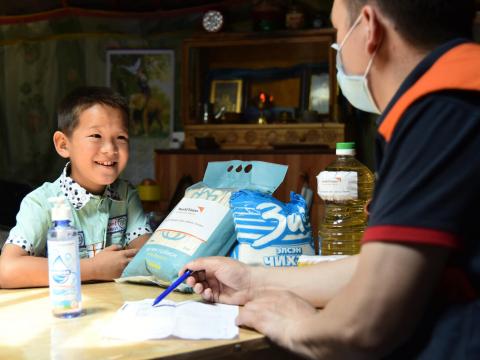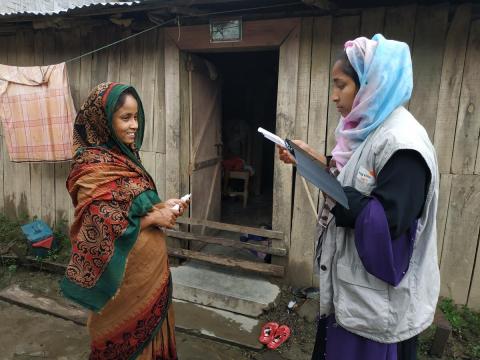
Food vouchers or food boxes? Here’s what we know
By Dr Kathryn Taetzsch and Sheri Arnott
Rather than divide us, if you look for it you can find countless examples of how much this pandemic is uniting people around the world. Discussions about food vouchers, food boxes, cash assistance, modalities and logistics, in global organisations that work with the world’s poorest people, have been conducted separately from those in developed countries. It’s becoming apparent that we need to join these conversations up.
COVID-19 has made a lot of things harder and more complicated. Lockdowns, local market and shop closures, as well as border restrictions have not only affected supply chains, both within and between countries, but also the ability of individuals to actually go to a ‘market’ to purchase food, even if they have money and there is sufficient food in the market to purchase. For us, however, it was pretty clear that for individuals and families, the devastating impact of losing livelihoods was the bigger issue, in both developing and developed countries. Responding to these needs has meant using every tool in our kits.
Last year, World Vision reached more than 16 million people with food, cash or vouchers. We reached more people with cash and vouchers than we ever have before – 6.4 million people, including nearly three million children, in 41 countries with US$410 million worth of cash and voucher assistance. We have been feeding millions of children for decades, and we have learned a thing or two in our time.
Here is what we know.
- In an emergency, cash and vouchers are hard to beat
Where markets are well functioning, the benefits of using cash and vouchers are clear – reduced logistics, storage, and handling costs; less chance of the anguish of rotten or expired food; contributing to local food markets and businesses; and, most of all, the dignity of choice for people experiencing the toughest times in their lives. We learned this lesson in over 15 years, including in other pandemic responses like Zika, Ebola and before COVID-19, and we put it into action when this unprecedented pandemic hit; we have assisted especially vulnerable people, (71% of them living in fragile contexts such as Central African Republic, Venezuela and Afghanistan) with more than US$ 410 million worth of cash vouchers as part of our humanitarian and recovery support to enable better nutrition, livelihoods, health, water and sanitation, child protection, education and mental health outcomes in 2020. Cash transfers are widely used by governments around the world as part of their responses to this crisis, although more work needs to be done to ensure they address the needs of vulnerable children. Evidence shows, time and again, that families spend cash and vouchers on their families’ most urgent and important needs. And we’re not talking about paper and coins – 61% of the cash and voucher transfers we made last year was delivered via e-cash and e-vouchers, which means more flexibility and transparency, all while socially distancing.
- There will always be a need for food packages, boxes and distributions
Where the storage and delivery logistics face challenges but supplies are readily available and of good quality, and reflect the choice and needs of people receiving them, providing food may be the best option. We saw this in the US in the first few months of our COVID-19 response, when World Vision distributed 1.6 million boxes of fresh meat, produce, and dairy in nearly every state of the country to serve four million people.
- No school means no food for millions
During the first few months of COVID-19 food projects all over the world were temporarily suspended, and it became quickly apparent that this was an unintended consequence of lockdowns and school closures. The majority of our school feeding programmes, which we run with our valued Nobel Prize-winning partners at the World Food Programme, were suspended at some point due to these government-mandated school closures; in May, we had 230,000 vulnerable children unable to access school meals due to school closures in some of the toughest places in the world. These are not children of families who can get online and put in an order from a local food supplier as part of a gig-economy door-to-door delivery. So, we innovated. We worked with partners on hybrid options – such as take-home school rations – to ensure, that children out of school could still benefit from the nutritious meals they normally get at school.
- There is no substitute for dignity
Regardless of what is distributed, we should never allow our focus to be taken away from the faces and stories of those who need food support when they fall on tough times; a hungry child, a mother unable to feed her children, a father who cannot figure out where the next meal will come from. Their voices and experiences must be heard, their rights to dignity and choice should always feature front and centre in decision making. It is not hard to do this, and in my experience there is never a good reason for not doing so!
Enabling families to build their resilience – emotionally and economically – in times of unprecedented crisis is paramount. This is at the heart of our work, and our message to governments and leaders around the world. Cash, vouchers or food distributions can do this, address urgent needs, and help families to build back better. But only if we are committed to learning from the lessons experience has already taught us.
Dr Kathryn Taetzsch is the head of World Vision's global cash and voucher-based programming work, and Sheri Arnott is a food security expert and policy director in World Vision's global humanitarian team.

